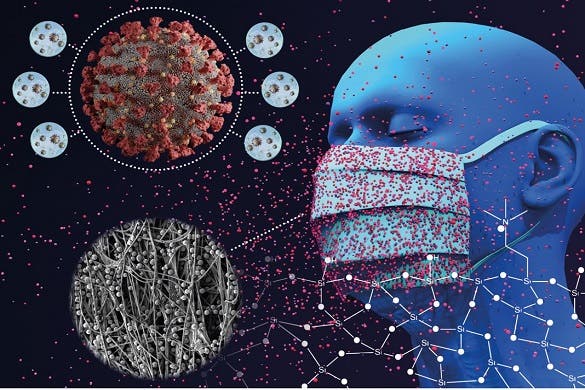Breakthrough new material traps coronavirus particles transforming face mask efficiency
Research unveils this state-of-the-art material’s ability, when incorporated into conventional face masks, to capture coronavirus proteins

[Sept. 27, 2023: Staff Writer, The Brighter Side of News]
A research team at the University has developed a new material that captures coronavirus particles and could transform the efficiency of face masks and other filter equipment to stop the spread of COVID-19 and other viruses. (CREDIT: Creative Commons)
In a groundbreaking move against the coronavirus and potential future outbreaks, a dedicated research team from the University of Liverpool has made a significant breakthrough. They've introduced a novel material poised to drastically boost the efficiency of face masks and other protective filter apparatus, which, in these uncertain times, could be a potential game-changer.
Published in the esteemed journal Nature Communications, the research unveils this state-of-the-art material's ability, when incorporated into conventional face masks, to capture proteins, specifically the coronavirus proteins, with an astonishing efficacy. Remarkably, it's approximately 93% more efficient than the current standards – all without compromising breathability.
But what sparked this innovative discovery?
At the helm of this scientific breakthrough are Professor Peter Myers and Dr. Simon Maher. Prof. Myers, a pioneer in the world of chromatography, and Dr. Maher, a luminary in the realm of mass spectrometry, form a dynamic duo. Their collaborative efforts initially revolved around the intricate world of high-performance liquid chromatography processes where proteins intriguingly "stick" to chromatographic support materials.
PyMOL computational images of the surface charge on the four proteins tested. (CREDIT: Nature Communications)
However, in the throes of the global pandemic, an ingenious idea struck Professor Myers. He speculated that by reversing this very process, a mechanism to effectively absorb proteins, especially the distinctive S1 spike protein enveloping the SARS-CoV-2 virus's outer lipid membrane, could be developed.
Wasting no time, the passionate team from the University of Liverpool’s Department of Chemistry and Electrical Engineering and Electronics embarked on a mission. Their goal was to "re-tune" the surface of the spherical silica particle—originally used for chromatography—such that it became highly "sticky" for the COVID-19 S1 spike protein.
Going a step further, they worked meticulously to amplify the silica particle's porosity. This enhancement ensured that the particle now boasted an enormous surface area—around 300m^2 per gram, astonishingly equivalent to that of a tennis court! Moreover, they increased the silica sphere's internal volume, ensuring it had a vast capacity to ensnare and "capture" the menacing virus.
Related Stories:
Beyond just the research stage, the novel material has successfully demonstrated its efficacy in real-world applications, not just limited to face masks but also including air filters used across planes, automobiles, and air conditioning systems.
SEM images of QA functionalised silica. QA functionalised silica attached to the substrate, and b silica particle (x1300) with a magnified image showing pores visible on the surface (x30,000). All data shown are representative of at least three independent experiments. (CREDIT: Nature Communications)
Collaborating with the Liverpool School of Tropical Medicine, the group also ingeniously crafted a method to affix these sticky particles to conventional face mask surfaces, adding another feather to their cap.
Filter efficiency of 4 different aerosolised proteins for the silica-coated cotton material and blank control cotton material. (CREDIT: Nature Communications)
Sharing his thoughts on this monumental achievement, Professor Peter Myers remarked, “This proof of concept research has only scratched the surface. While COVID-19's immediate threat has diminished, the versatility of this material can't be overstated. It holds immense potential across a plethora of applications. Our enthusiastic research team is now delving into advancing these “sticky” surfaces for diverse bioaerosols. This includes the newer Covid variant BA.2.86 and other potentially lethal viruses, such as influenzas and the dreaded Nipah.”
As the world grapples with the aftermath of the pandemic and the looming threat of new viruses, the innovation from the University of Liverpool offers a glimmer of hope. It's not just about battling the current menace but also about equipping humanity with superior tools to combat any future bioaerosol threats. With minds like Professor Myers and Dr. Maher at the forefront, the future seems a tad brighter and safer.
Keywords: University of Liverpool, Nature Communications, coronavirus, face masks, filter equipment, proteins, SARS-CoV-2, S1 spike protein, chromatography, mass spectrometry, Professor Peter Myers, Dr. Simon Maher, spherical silica particle, bioaerosols, Covid variant BA.2.86, influenza, Nipah virus.
Note: Materials provided above by The Brighter Side of News. Content may be edited for style and length.
Like these kind of feel good stories? Get the Brighter Side of News' newsletter.
Joseph Shavit
Head Science News Writer | Communicating Innovation & Discovery
Based in Los Angeles, Joseph Shavit is an accomplished science journalist, head science news writer and co-founder at The Brighter Side of News, where he translates cutting-edge discoveries into compelling stories for a broad audience. With a strong background spanning science, business, product management, media leadership, and entrepreneurship, Joseph brings a unique perspective to science communication. His expertise allows him to uncover the intersection of technological advancements and market potential, shedding light on how groundbreaking research evolves into transformative products and industries.



